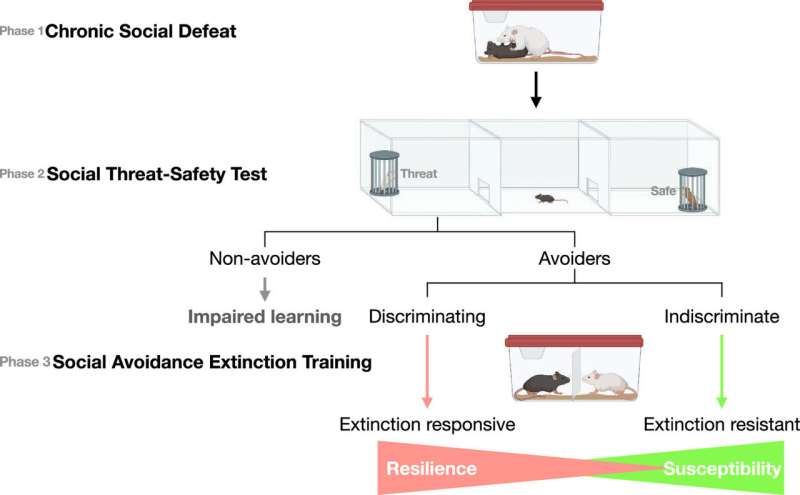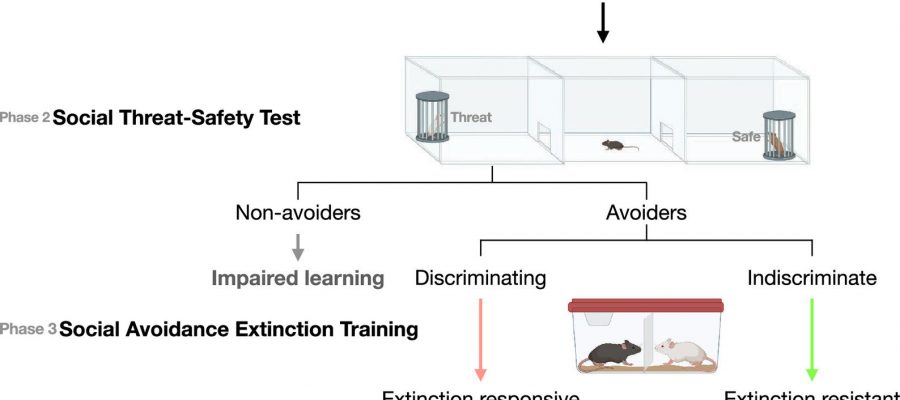
Why does stress trigger the development of mental disorders, such as depression, in one person, while others successfully maintain mental health despite adversity? This latter case is referred to as the phenomenon of resilience. Yet the neuronal circuits and neurobiological mechanisms that underlie this individual resilience are still not sufficiently understood.
Scientists at the Leibniz Institute for Resilience Research in Mainz have therefore developed a translationally valid experimental approach that enables to model fundamental mechanisms of resilience in mice. They were able to show that a critical balance within the fear circuit is of fundamental importance for resilience: Resilient animals can discriminate potentially threatening from safe social stimuli particularly well and show the ability to efficiently extinguish negative memories. The results of the study are published in the current issue of the Proceedings of the National Academy of Sciences.
Social species, including humans, evaluate their interactions with conspecifics by their potential for harm or benefit, and the ability to discriminate different social stimuli is of fundamental importance in this context. It is known that three characteristics are particularly important here, namely:
- Individuals can learn from negative experiences and apply learned knowledge to future social events so that an optimized behavioral adjustment can evolve
- Individuals can precisely discriminate the quality of stimuli (positive/negative) in order to prevent a so-called generalization of the fear reaction, which would result in an undesired spread of fear to originally neutral stimuli
- Individuals succeed in extinguishing negative memories, i.e., forgetting them again
If these three characteristics are well developed, an individual is most likely to be resilient. Conversely, there is substantial evidence that these characteristics are not optimally expressed, for example, in patients with anxiety disorders and stress-related affective disorders.
Worldwide, mental disorders, and in particular stress-associated affective disorders, are one of the most leading causes of disability-related work loss. In light of numerous global crises such as the COVID pandemic, war or natural disasters, developing targeted interventions to prevent stress-associated mental illnesses is more important than ever.
A promising approach for prevention is to target and specifically strengthen individual resilience. However, the development of tailored prevention approaches requires the best possible understanding of the neurobiological mechanisms underlying resilience. Experimental approaches involving animal models can make a significant contribution to the understanding of such fundamental mechanisms.
But still one question remains: How can we recognize a resilient mouse? To answer this question, scientists at the Leibniz Institute for Resilience Research (LIR) in Mainz, together with their collaboration partners from the University Medical Center Mainz, have developed an experimental approach to translate the above-mentioned characteristics into an animal model and study them in detail. In this way, they succeeded in showing that—just as in humans—there are also individuals in mice who are particularly successful in discrimination between potentially threatening and neutral social stimuli, and in whom the extinction of negative memories is also especially effective.
“It is fascinating to learn that we can model basic processes of the fear circuit and their importance for resilience to social stress, as known from studies in humans, in the mouse. Resilient mice exhibit the same characteristics as resilient humans,” explains Marianne Müller, Principal Investigator at the Leibniz Institute for Resilience Research.
“The behavioral differences between resilient and non-resilient mice were further confirmed by brain-area-specific differences in so-called transcriptome signatures. These signatures constitute a ‘fingerprint’ of the genetic information and provide us with an in-depth insight into the underlying cellular processes of resilience. We thus obtained first clues about the molecular mechanisms underlying the different behavioral patterns.”
“We have succeeded in developing an experimental model that allows us to further elucidate the neurobiological mechanisms of resilience across species, i.e., from mice to humans and in a truly translational approach,” adds Sarah Ayash, first author of the study. “This is why in the long-term, we expect our model to facilitate the development of individualized and targeted prevention of stress-related mental disorders.”
More information:
Sarah Ayash et al, Fear circuit-based neurobehavioral signatures mirror resilience to chronic social stress in mouse, Proceedings of the National Academy of Sciences (2023). DOI: 10.1073/pnas.2205576120
Journal information:
Proceedings of the National Academy of Sciences
Source: Read Full Article
